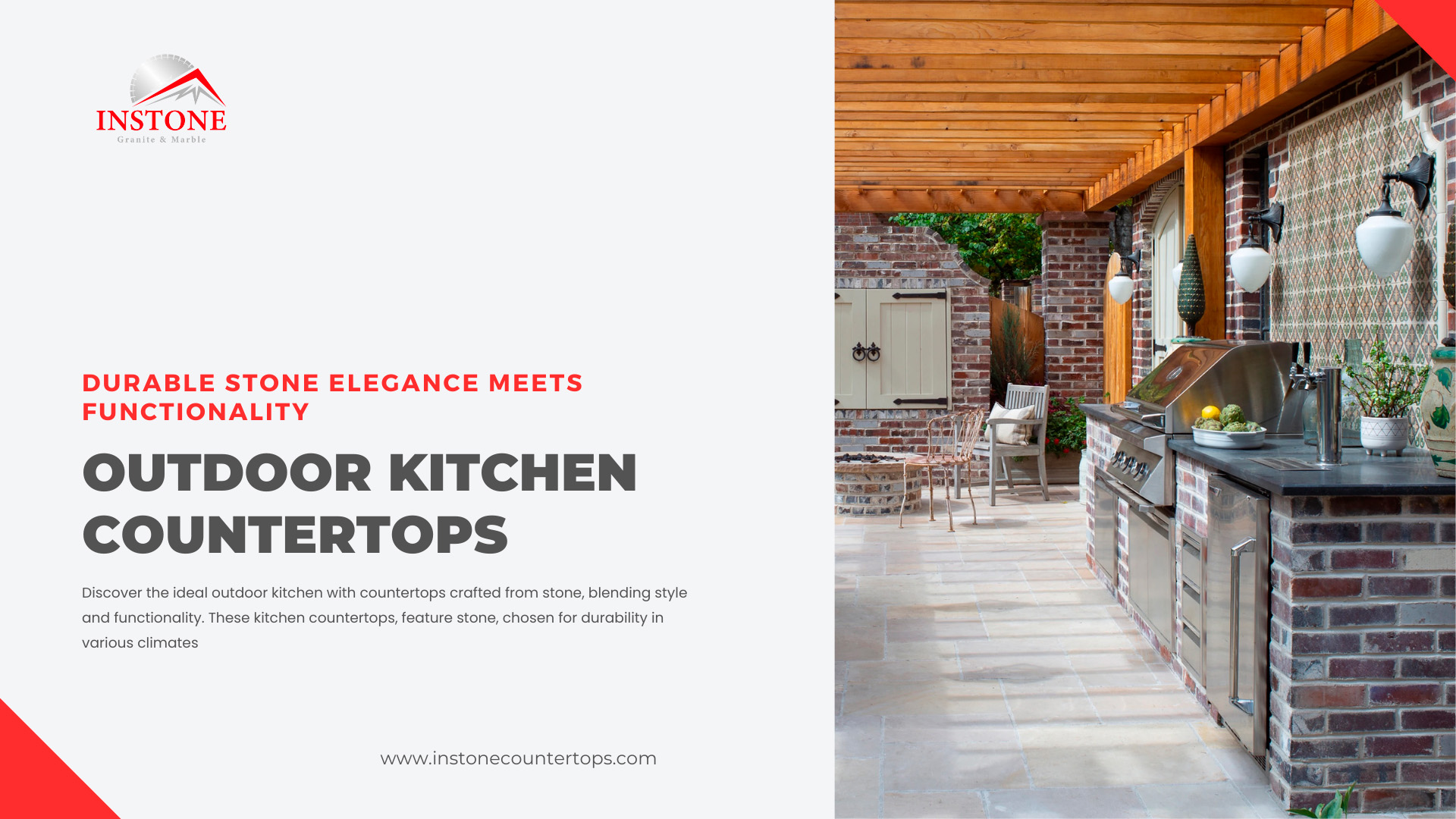How to Plan and Build Outdoor Countertops
When designing an outdoor kitchen, selecting the right countertop material is crucial for balancing durability, style, and functionality. Consider these key factors:
- Climate Compatibility: Choose a material that withstands local weather conditions. Options like Granite, Marble, Quartz, and Quartzite vary in their resilience to elements like sun and rain.
- Aesthetic Harmony: Ensure the outdoor kitchen worktops align with your outdoor kitchen’s design theme. Whether it’s a rustic look or a modern vibe, the right material can enhance the overall appeal.
- Durability and Maintenance: Opt for materials that offer a blend of longevity and ease of upkeep. Some might need periodic maintenance like sealing.
- Functional Suitability: Reflect on how the countertop will be used—whether for heavy-duty cooking or social gatherings—and select a material that caters to these activities.
In essence, the ideal outdoor kitchen countertop marries your lifestyle needs with the environmental demands and design ethos of your outdoor space.
Countertop Material Options
Granite
Granite has long been a preferred choice for outdoor countertops, offering a blend of durability, functionality, and style. Here’s a deeper look at why granite stands out as an exceptional outdoor countertop option:
Durability and Resistance:
- Scratch and Stain Resistance: Granite, being a hard stone, is highly resistant to scratches and stains. This quality makes it ideal for granite open countertops where the countertops are frequently used for food preparation.
- Heat Resistance: It is remarkably resilient in environments that are hot or in direct sunlight. Granite won’t fade or degrade under sun exposure, unlike some other materials.
- Resistance to Cracking: Unlike options like porcelain tile or certain types of concrete, granite has a lower risk of cracking under temperature changes, making it suitable for both hot and cold climates.
Maintenance and Longevity:
- Sealing Requirements: While granite is easy to clean, it requires periodic resealing to maintain its resistance against the elements. This is a simple process that ensures the longevity of the countertop.
- Outdoor Use vs. Indoor Use: Granite used outdoors is subjected to more rigorous conditions than indoor countertops. Outdoor granite countertops are specifically designed to endure these conditions without the deterioration that materials like particle board would experience.
Aesthetic and Design Flexibility:
- Natural Beauty: Granite countertops come in a wide range of colors and patterns, offering the widest range of style options among outdoor countertop materials. This natural stone can seamlessly integrate with various outdoor kitchen designs, from rustic to modern.
Marble
Marble countertops, often chosen for their exquisite beauty, bring a luxurious element to outdoor kitchens and outdoor bar countertops. While they are a visually appealing stone option, there are several important factors to consider when selecting marble for outdoor use.
Porosity and Weather Resistance:
- Porous Nature: Marble’s porosity makes it more susceptible to staining and weather-related wear. In open settings, particularly in areas with high humidity and moisture, these countertops require more attention to prevent damage.
- Risk of Cracking and Fading: Marble can be prone to cracking with temperature fluctuations, especially in colder climates. Additionally, when exposed to prolonged sunlight, marble countertops may fade, losing some of their vibrant colors.
Maintenance and Care:
- Sealing Requirements: To preserve its appearance and protect against stains, marble countertops need to be sealed more frequently than other materials like granite or dekton. This maintenance is crucial to ensure the longevity of the marble in an outdoor environment.
- Cleaning and Upkeep: Regular cleaning is essential to maintain the pristine look of marble. Special care should be taken during food prep and cleaning to avoid any potential damage to the surface.
Aesthetics and Design:
- Luxurious Appeal: Marble is renowned for its elegant patterns and colors, offering a high-end look to any outdoor cooking space. Kitchen designers often recommend marble for its unparalleled natural beauty.
- Comparative Options: When compared to other stone options like granite, soapstone, or quartz, marble stands out for its aesthetic appeal but may fall short in terms of durability and maintenance ease.
Practical Considerations:
- Best Use Cases: Marble is best suited for outdoor kitchens that are more focused on entertainment and aesthetics rather than heavy-duty food prep. It’s a great countertop option for those looking to make a statement in their open space.
- Alternative Options: For homeowners seeking less maintenance-intensive materials, alternatives like concrete outdoor countertops, soapstone, or outdoor quartz countertops might be more practical, especially in varying climate conditions.
Quartz
Quartz countertops, a popular choice for indoor kitchens due to their durability and modern aesthetic, present unique considerations when used in outdoor settings. While they offer several advantages, their performance under outdoor conditions needs careful evaluation.
Durability and Environmental Sensitivity:
- Temperature Sensitivity: One of the critical aspects of quartz countertops is their sensitivity to temperature extremes. They are at a great risk of cracking in environments that fluctuate between cold and hot, making them less ideal for areas with significant seasonal changes.
- Sunlight Exposure: Quartz countertops are also known to fade when exposed to continuous direct sunlight. This fading can alter the appearance of the countertop over time, affecting its aesthetic appeal.
Comparison with Indoor Use:
- Indoor vs. Outdoor: While quartz is a robust material for indoor kitchen countertops, its susceptibility to outdoor elements makes it a less favorable option for outdoor use. In an indoor setting, these countertops don’t face the same level of exposure to sunlight and temperature extremes.
- Manufacturing Differences: The way quartz countertops are made, typically involving a combination of natural quartz and polymer resins, contributes to their sensitivity to outdoor conditions.
Quartzite
Quartzite countertops are increasingly gaining popularity in outdoor kitchen design, appreciated for their blend of durability and aesthetic appeal. Here’s a closer look at the characteristics of quartzite, making it a favorable option for open settings.
Durability and Resilience:
- Resistance to Elements: Quartzite’s composition renders it highly resistant to various outdoor elements. It stands up well against fading in the sun and doesn’t degrade easily when exposed to hot conditions in direct sunlight.
- Hardness and Scratch Resistance: This material is known for its hardness, rivaling that of granite. This makes quartzite countertops extremely resistant to scratches, an essential feature for outdoor kitchens where heavy-duty use is common.
- Maintenance: Like granite, quartzite is easy to clean, contributing to its practicality in outdoor spaces. However, it is crucial to reseal quartzite worktops periodically to protect them from stains and weather-induced damage.
Aesthetic Qualities:
- Visual Appeal: Quartzite offers a visual appeal similar to marble, making it an attractive choice for homeowners seeking a blend of modern design and natural beauty in their kitchens.
- Variety of Styles: With its wide range of colors and patterns, quartzite countertops can complement various design themes, from rustic to contemporary outdoor settings.
How to Budget Outdoor Kitchen Countertop
When planning your budget for outdoor counter top, consider these key points:
- Marble: A high-end option with luxurious appeal but higher maintenance costs.
- Granite: A mid-range choice, offering durability with moderate maintenance needs.
- Quartz: Also mid-range, but less suitable for outdoor use due to its sensitivity to weather elements.
- Quartzite: Comparable to granite in cost, it strikes a balance between durability and aesthetic appeal.
Remember to factor in installation costs and long-term maintenance for outdoor stone kitchen countertops. The right choice depends on balancing your budget with the desired look and durability of the worktop.
Conclusion
Choosing the right materials for an outdoor kitchen countertop is indeed a delicate balance between functionality, aesthetics, durability, and budget. Whether you opt for granite, marble, or quartz, it’s essential to ensure that your selection aligns with your vision of the ideal outdoor living space. Additionally, the chosen countertop material should be capable of withstanding the local climate and cater to your culinary and entertainment requirements. With thoughtful planning and the selection of the best countertop for your outdoor kitchen, you can create a space that is not only stylish and functional but also enduring and within your budget.



